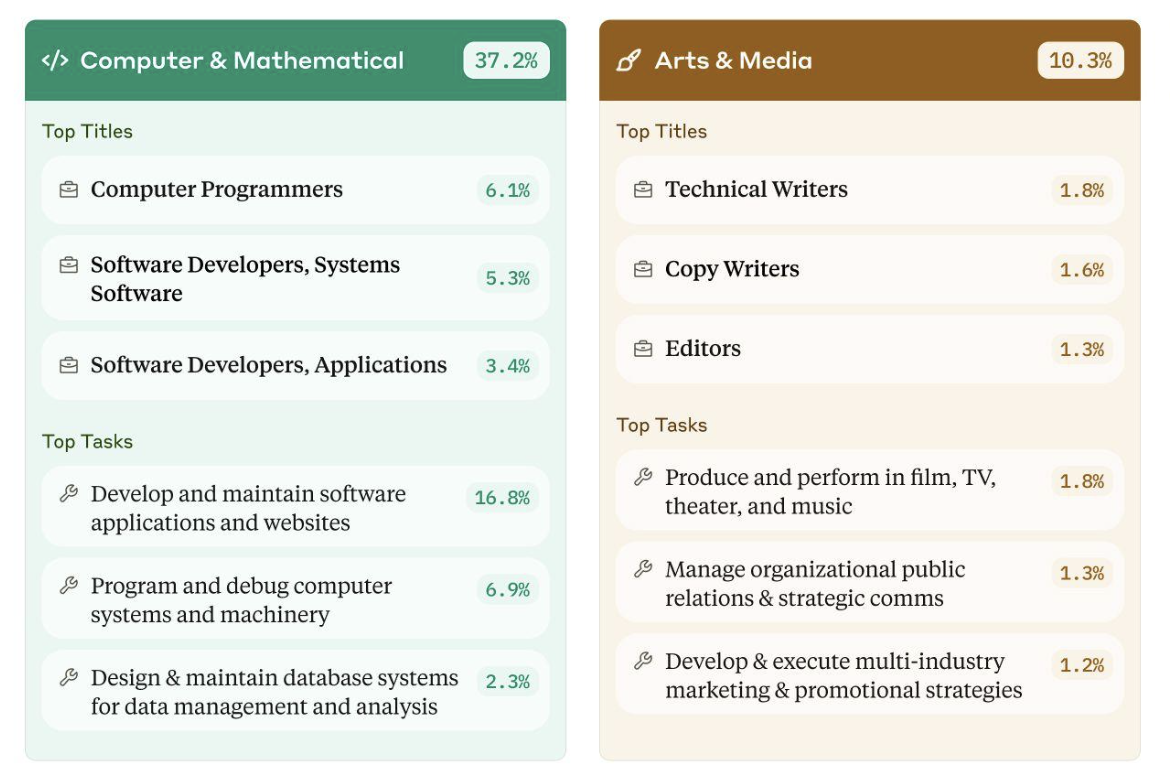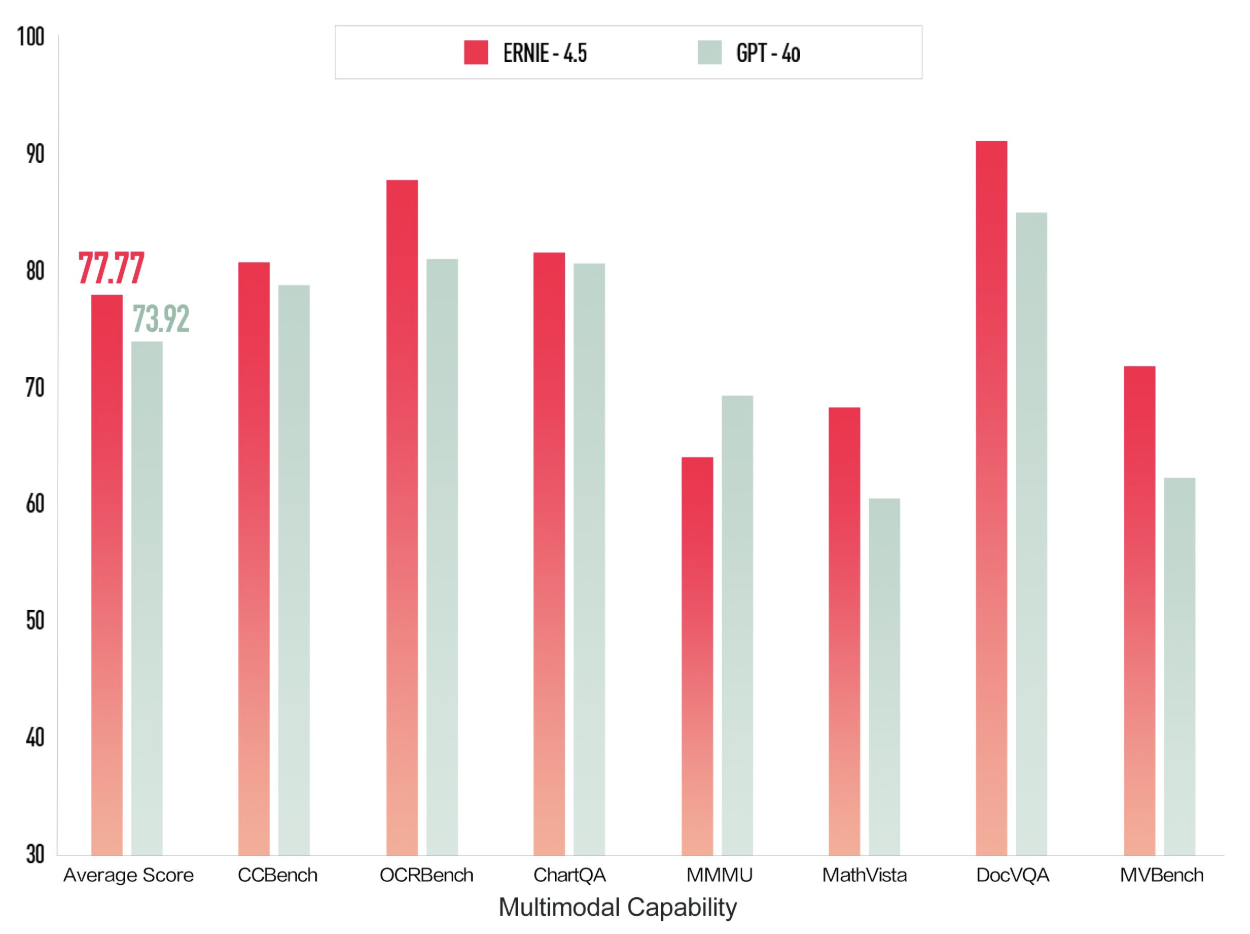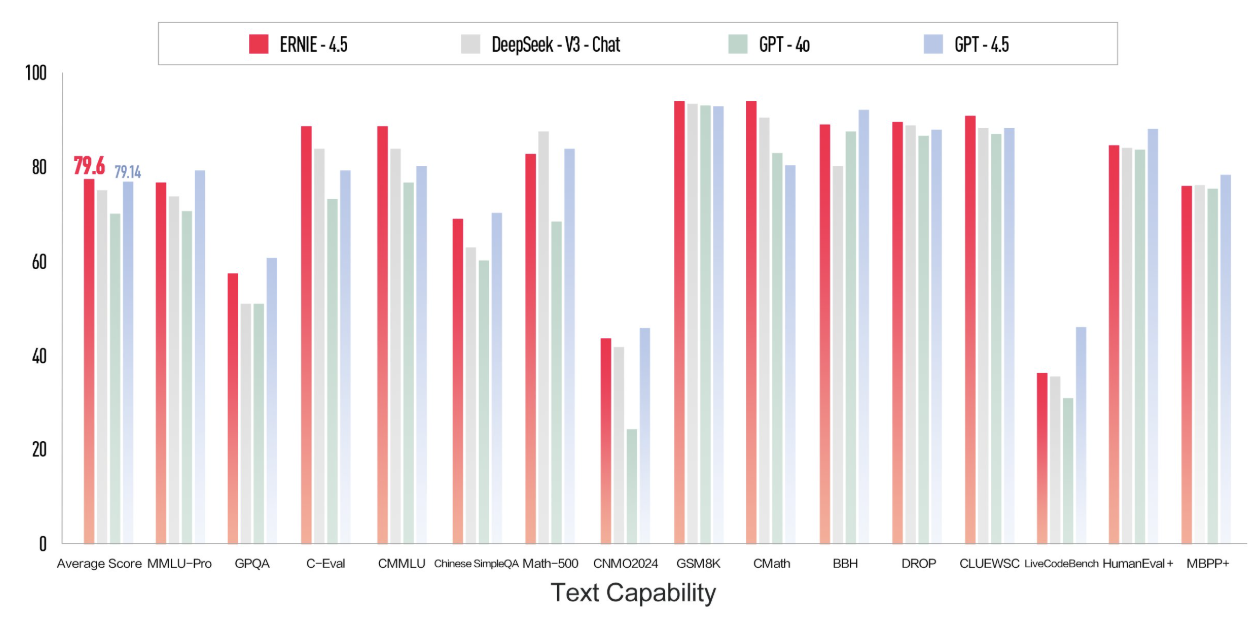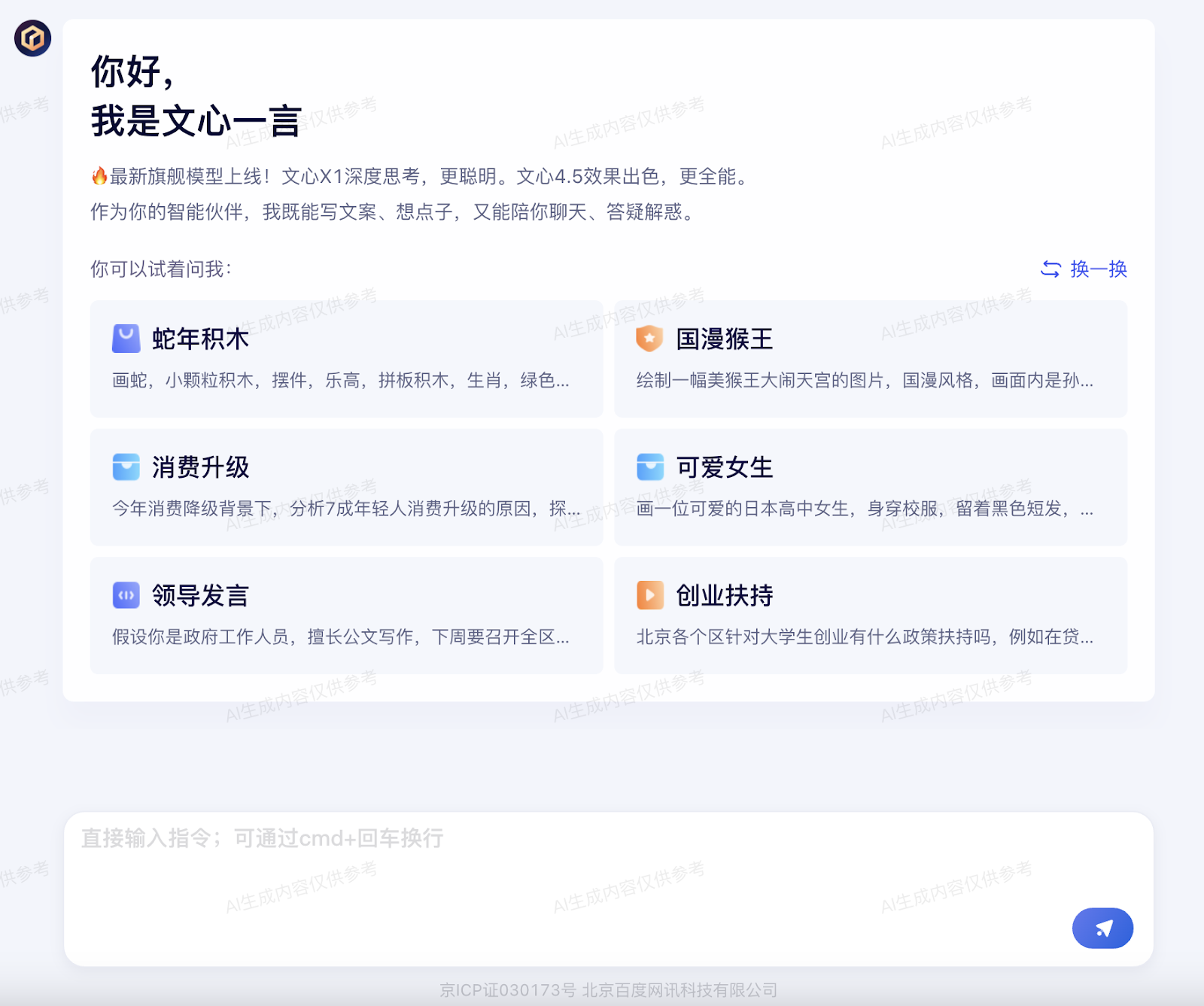Track
Baidu recently announced two new AI models: ERNIE 4.5 and ERNIE X1.
ERNIE 4.5 is a generalist multimodal model useful for everyday tasks, competing with OpenAI’s GPT-4o and DeepSeek’s V3.
ERNIE X1, on the other hand, is a specialized reasoning model designed for advanced tasks such as mathematics and complex coding. It will enter a highly competitive market, alongside DeepSeek-R1 and OpenAI’s o3-mini.
Baidu’s biggest selling point for the X1 model is that it’s twice as cheap as DeepSeek-R1 while supposedly offering similar performance. So far, however, we haven’t seen any benchmarks for X1, so this claim remains to be verified.
On the other hand, ERNIE 4.5 does have good benchmark results, but it doesn’t seem particularly user-friendly for audiences outside China, which I think will significantly impact its adoption.
Will Baidu’s new ERNIE releases constitute another “DeepSeek moment”? My initial impression is—not really. But let’s learn more about these new models. In this blog, I’ll cut through the noise and break down the essentials of ERNIE 4.5 and X1.
We keep our readers updated on the latest in AI by sending out The Median, our free Friday newsletter that breaks down the week’s key stories. Subscribe and stay sharp in just a few minutes a week:
What Is Baidu’s ERNIE 4.5?
ERNIE 4.5 is Baidu’s latest multimodal AI model—a versatile generalist designed for everyday tasks and interactions. As a multimodal system, ERNIE 4.5 handles multiple data types at once, integrating text, images, audio, and video.
In the short official demo, we see an example of ERNIE 4.5 working with text and video:
This isn’t Baidu’s first step into AI. The company, originally founded in 2000 as China’s leading search engine (often called the “Google of China”), began seriously investing in artificial intelligence several years ago. Baidu has been developing ERNIE (Enhanced Representation through Knowledge Integration) since 2019, and they released the ERNIE Bot in 2023.
However, Baidu’s dominance in the Asian AI market has recently come under pressure from Alibaba’s Qwen models and innovative new competitors like DeepSeek.
With ERNIE 4.5, Baidu directly competes with DeepSeek’s V3, Qwen 2.5 Max, or OpenAI’s GPT-4o.
What Is Baidu’s ERNIE X1?
ERNIE X1 is a specialized reasoning model designed for advanced tasks such as mathematics and complex coding. Similar to DeepSeek-R1 or OpenAI’s o1, this type of model explicitly shows its thought process to the user, making it easier to understand how it arrives at a particular answer or solution.
Companies continue investing heavily in reasoning-focused models like ERNIE X1 because these models directly target tasks that bring clear business value. According to recent data from Anthropic, reasoning and coding tasks are the top enterprise use cases, making up a significant portion of AI adoption.

Source: The Anthropic Economic Index
Despite AI’s rapid development, enterprise adoption remains low globally, and models that excel in reasoning-intensive domains (math, coding, advanced analytics) are more likely to deliver tangible business value, driving revenue and accelerating AI adoption in the enterprise market.
Baidu’s main selling point for ERNIE X1 is its aggressive pricing strategy. Here’s a quick comparison to DeepSeek-R1 (pricing information is accurate as of March 17, 2025):
|
Model |
Input Cost (lowest) per 1M tokens |
Output Cost per 1M tokens |
|
DeepSeek-R1 |
$0.135 (discounted) – $0.55 (standard) |
$0.55 (discounted) – $2.19 (standard) |
|
ERNIE X1 |
$0.28 |
$1.10 |
At standard rates (and excluding content caching), Baidu’s claim—that ERNIE X1 matches DeepSeek-R1 performance at half the price—holds true, particularly regarding output token pricing.
However, under DeepSeek’s discounted rates (which apply during 16:30-00:30 UTC each day), the reverse claim applies: ERNIE X1 becomes twice as expensive.
Despite attractive pricing, Baidu has yet to provide detailed benchmarks confirming ERNIE X1’s performance relative to DeepSeek-R1, which leaves some uncertainty about its real-world competitiveness.
While we wait for benchmarks on ERNIE X1, let’s find more details on the performance of ERNIE 4.5.
ERNIE 4.5 Benchmarks
Baidu released benchmarks comparing ERNIE 4.5 to leading multimodal and text-based models, including OpenAI’s GPT-4o, GPT-4.5, and DeepSeek’s V3. Let’s walk through the key results, starting with multimodal capabilities.
Multimodal benchmarks
In multimodal benchmarks, ERNIE 4.5 outperformed GPT-4o, achieving an average score of 77.77, compared to GPT-4o’s 73.92—a lead of 3.85 points.

Source: Baidu
Specifically, ERNIE 4.5 surpassed GPT-4o in six out of seven evaluated benchmarks:
- CCBench: Evaluates common-sense reasoning across text and images. ERNIE 4.5 scored approximately 81, slightly outperforming GPT-4o’s ~79.
- OCRBench: Assesses optical character recognition capabilities, focusing on text extraction from images. ERNIE 4.5 achieved around 88, surpassing GPT-4o’s ~81.
- ChartQA: Tests understanding of data presented in charts. ERNIE 4.5 scored ~82, marginally ahead of GPT-4o’s ~81.
- MMMU: Measures multimodal reasoning across various topics. Here, GPT-4o led with ~70, while ERNIE 4.5 scored ~64, indicating an area for improvement.
- MathVista: Evaluates mathematical reasoning in visual contexts. ERNIE 4.5 scored ~69, outperforming GPT-4o’s ~61.
- DocVQA: Assesses the ability to answer questions based on document visuals. ERNIE 4.5 excelled with a score of ~91, compared to GPT-4o’s ~85.
- MVBench: Focuses on temporal understanding in dynamic video tasks, requiring reasoning over sequences of frames. ERNIE 4.5 scored ~72, significantly outperforming GPT-4o’s ~63.
Text-only benchmarks
On text-only tasks, ERNIE 4.5 achieved an average score of 79.6, slightly ahead of GPT-4.5’s average of 79.14, and also surpassing DeepSeek-V3 (~77).

Source: Baidu
These results suggest that ERNIE 4.5 is particularly competitive in multimodal document understanding, mathematics, and Chinese language benchmarks. However, its weaker performance on specific coding benchmarks, such as LiveCodeBench, highlights potential limitations in specialized coding tasks.
Let’s quickly break down a few key benchmarks:
- MMLU-Pro: Assesses multitask learning across various disciplines. ERNIE 4.5 scored ~78, slightly below GPT-4.5’s ~79.
- GPQA: Evaluates general-purpose question answering. ERNIE 4.5 achieved ~57, trailing GPT-4.5’s ~61.
- C-Eval: Measures Chinese general knowledge and reasoning. ERNIE 4.5 led with ~88, outperforming GPT-4.5’s ~80.
- CMMLU: Tests Chinese-language multitask understanding. ERNIE 4.5 scored ~88, ahead of GPT-4.5’s ~80.
- Math-500: Measures a model's ability to solve challenging high-school-level mathematical problems. ERNIE 4.5 (~82) is behind the leader DeepSeek-V3 (~88) and GPT-4.5 (~84).
- CMath: Evaluates math problem-solving in Chinese. ERNIE 4.5 led with ~95, surpassing DeepSeek-V3’s ~85.
- LiveCodeBench: Measures real-time coding abilities. ERNIE 4.5 scored ~35, below GPT-4.5’s ~45, indicating room for improvement in coding tasks.
How to Access ERNIE 4.5 and ERNIE X1
You can directly try Baidu’s ERNIE 4.5 and X1 through the official chatbot application available on their website: yiyan.baidu.com.
However, based on my personal experience, there are a few usability issues. The interface is currently available primarily in Chinese, making it challenging for non-Chinese speakers—while you can use the browser’s automatic translation feature, the translation is not smooth and the UX suffers.

Source: Baidu
Additionally, Google or GitHub login is unavailable, a problem I haven’t encountered with competitors like DeepSeek or Qwen. I still tried to create an account, but I wasn’t allowed to complete the registration form with my European phone number.
How to access ERNIE via API
For developers interested in integrating ERNIE 4.5, API access is already available via Baidu’s official platform, Qianfan. Pricing starts at $0.55 per 1 million input tokens and $2.20 per 1 million output tokens.
As of March 17, 2024, ERNIE X1 is not yet available through the API, but Baidu mentioned that it will be soon.
Moreover, Baidu has announced plans to open-source ERNIE 4.5 starting June 30, 2025. This step could improve adoption internationally by making the model more accessible and adaptable.
Baidu also intends to integrate ERNIE 4.5 and X1 into various products across its ecosystem—including Baidu Search and the Wenxiaoyan App—though timelines and details remain to be confirmed.
ERNIE’s Impact on the AI Market
The release of Baidu’s ERNIE 4.5 and ERNIE X1 continues a notable pattern I’ve seen emerging in China’s AI industry—a strategy of prioritizing disruption over immediate usability.
Unlike companies such as Google, OpenAI, or Mistral, which typically spend extensive periods (often 8–12 months or more) ensuring their products meet stringent stability, security, privacy, and safety standards, Chinese AI companies seem to favor rapidly deploying products that are compelling yet still in an early, unpolished state.
Just like ManusAI and DeepSeek, Baidu’s ERNIE models follow a similar trend. They enter the market aggressively, aiming primarily to disrupt pricing structures and competitive assumptions. The ERNIE X1 model, in particular, explicitly positions itself as comparable in performance to DeepSeek-R1 at half the cost—even though Baidu hasn’t yet publicly backed these claims with detailed benchmarks.
And, while ERNIE 4.5 shows genuinely competitive benchmark results, international users like myself still encounter barriers, notably a challenging sign-up process and language accessibility issues.
Overall, the ERNIE 4.5 and X1 releases reinforce the idea that Chinese AI companies are comfortable sacrificing some stability and user experience in the short term, as long as they’re able to quickly push the market forward and provoke industry-wide conversations.
Whether this approach is sustainable remains to be seen, but there’s no denying it’s effective at forcing the global AI market to move faster and think differently about what it means to compete in the current market.
Conclusion
Baidu’s release of ERNIE 4.5 and ERNIE X1 represents yet another ambitious step in China’s competitive AI landscape. ERNIE 4.5 demonstrates clear strengths, particularly in multimodal understanding, mathematics, and Chinese-language tasks, positioning it strongly against global rivals like GPT-4o and DeepSeek V3.
On the other hand, ERNIE X1’s promise of delivering advanced reasoning capabilities at half the cost of DeepSeek-R1 is intriguing—but without benchmarks, it remains speculative.
As these models mature, it’ll be interesting to see whether Baidu and similar Chinese companies adjust their approach to strike a better balance between disruption and stability.
FAQs
Does Ernie 4.5 support languages other than Chinese?
Currently, Ernie 4.5 primarily supports Chinese and English, though its strongest performance is in Chinese-language tasks. Official support for additional languages hasn’t been announced yet.
When exactly will Ernie X1 become available via Baidu’s API?
Baidu hasn’t provided an exact date yet, but they mentioned Ernie X1 will be available through APIs on their Qianfan MaaS platform soon.
What hardware resources do I need to run Ernie 4.5 locally after it goes open-source?
Baidu hasn’t released detailed hardware requirements yet, but typically large multimodal models require powerful GPUs (like Nvidia A100s or H100s) and substantial RAM resources.
Is there a limit on the free usage of Ernie Bot for individual users?
Baidu hasn’t clarified specific usage limits yet, but it’s common for such chatbots to impose daily or monthly limits to manage server load.
Can businesses outside of China easily access and integrate Ernie 4.5 into their systems via API?
Technically yes, via Baidu’s Qianfan MaaS platform; however, practical barriers—such as registration issues or language support—may complicate international adoption.
How secure are Ernie 4.5 and X1 regarding data privacy?
Baidu hasn’t released detailed documentation on data privacy or compliance certifications yet, making thorough assessments difficult for now, especially for enterprises outside China.
Are there alternatives to Ernie 4.5 and X1 within China that might offer smoother international user experiences?
Yes, Alibaba’s Qwen and DeepSeek’s models currently provide smoother international accessibility, including simpler registration processes and better English-language support.
I’m an editor and writer covering AI blogs, tutorials, and news, ensuring everything fits a strong content strategy and SEO best practices. I’ve written data science courses on Python, statistics, probability, and data visualization. I’ve also published an award-winning novel and spend my free time on screenwriting and film directing.




